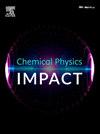Identification of potential inhibitors of Ubiquitin carboxyl-terminal hydrolase 21 from repurposed drugs: Implications in anticancer therapeutics
IF 3.8
Q2 CHEMISTRY, PHYSICAL
引用次数: 0
Abstract
Ubiquitin carboxyl-terminal hydrolase 21 (USP21) is involved in the regulation of multiple cellular processes and participates in tumorigenesis. Due to its importance in the onset and progression of cancer, USP21 has become an appealing target in anticancer drug discovery. Therefore, this study aimed to screen a collection of repurposed drugs from the DrugBank 6.0 database for possible USP21 inhibitors. At the beginning of the selection process, the library was filtered by the binding efficiency to USP21, which identified a few drug molecules with appreciable binding affinity towards the USP21 binding pocket. These shortlisted molecules were then scrutinized based on their drug profiles and biological activities, with reference to their anticancer potential. Among them, Nilotinib and Radotinib were identified as the top candidates, with higher Pa values for anticancer activity. The interaction analysis and molecular dynamics (MD) simulation study further confirmed that both Nilotinib and Radotinib bind to the important and common residues of the USP21 binding site, which may inhibit the aberrant activity of USP21 in pathological conditions. The 500 ns MD simulations showed that both drugs are capable of binding to USP21 without any significant structural changes, which justifies their likelihood of being used as repurposed agents for cancer treatment. The RMSD, Rg, and hydrogen bond analyses showed minimal fluctuations, indicating high conformational stability. Additionally, free energy landscape (FEL) analysis supported the stability of the complexes. These results suggest that Nilotinib and Radotinib could serve as promising repurposed agents for USP21 inhibition in cancer treatment after required validation. In conclusion, the combination of docking and MD simulations highlights their potential therapeutic relevance, laying the groundwork for further development of USP21 inhibitors as anticancer drugs.

从再利用药物中鉴定泛素羧基末端水解酶21的潜在抑制剂:在抗癌治疗中的意义
泛素羧基末端水解酶21 (Ubiquitin carboxyl-terminal hydrolase 21, USP21)参与多种细胞过程的调控,参与肿瘤发生。由于其在癌症的发生和发展中的重要性,USP21已成为抗癌药物发现的一个有吸引力的靶点。因此,本研究旨在从DrugBank 6.0数据库中筛选一系列可能的USP21抑制剂。在筛选过程的开始,对文库进行与USP21结合效率的筛选,筛选出少数与USP21结合袋具有明显结合亲和力的药物分子。然后,根据这些候选分子的药物特征和生物活性,以及它们的抗癌潜力,对它们进行仔细审查。其中,尼罗替尼和拉多替尼被确定为最佳候选药物,具有较高的Pa值的抗癌活性。相互作用分析和分子动力学(MD)模拟研究进一步证实,尼罗替尼和拉多替尼都结合到USP21结合位点的重要和常见残基上,可能在病理状态下抑制USP21的异常活性。500 ns MD模拟表明,这两种药物都能够与USP21结合,而没有任何显著的结构变化,这证明它们有可能被用作癌症治疗的重新用途药物。RMSD、Rg和氢键分析显示波动最小,表明构象稳定性高。此外,自由能景观(FEL)分析支持配合物的稳定性。这些结果表明,经过必要的验证,尼洛替尼和拉多替尼可以作为有希望的USP21抑制药物用于癌症治疗。总之,对接和MD模拟的结合突出了它们潜在的治疗相关性,为进一步开发USP21抑制剂作为抗癌药物奠定了基础。
本文章由计算机程序翻译,如有差异,请以英文原文为准。
求助全文
约1分钟内获得全文
求助全文
来源期刊

Chemical Physics Impact
Materials Science-Materials Science (miscellaneous)
CiteScore
2.60
自引率
0.00%
发文量
65
审稿时长
46 days
 求助内容:
求助内容: 应助结果提醒方式:
应助结果提醒方式:


